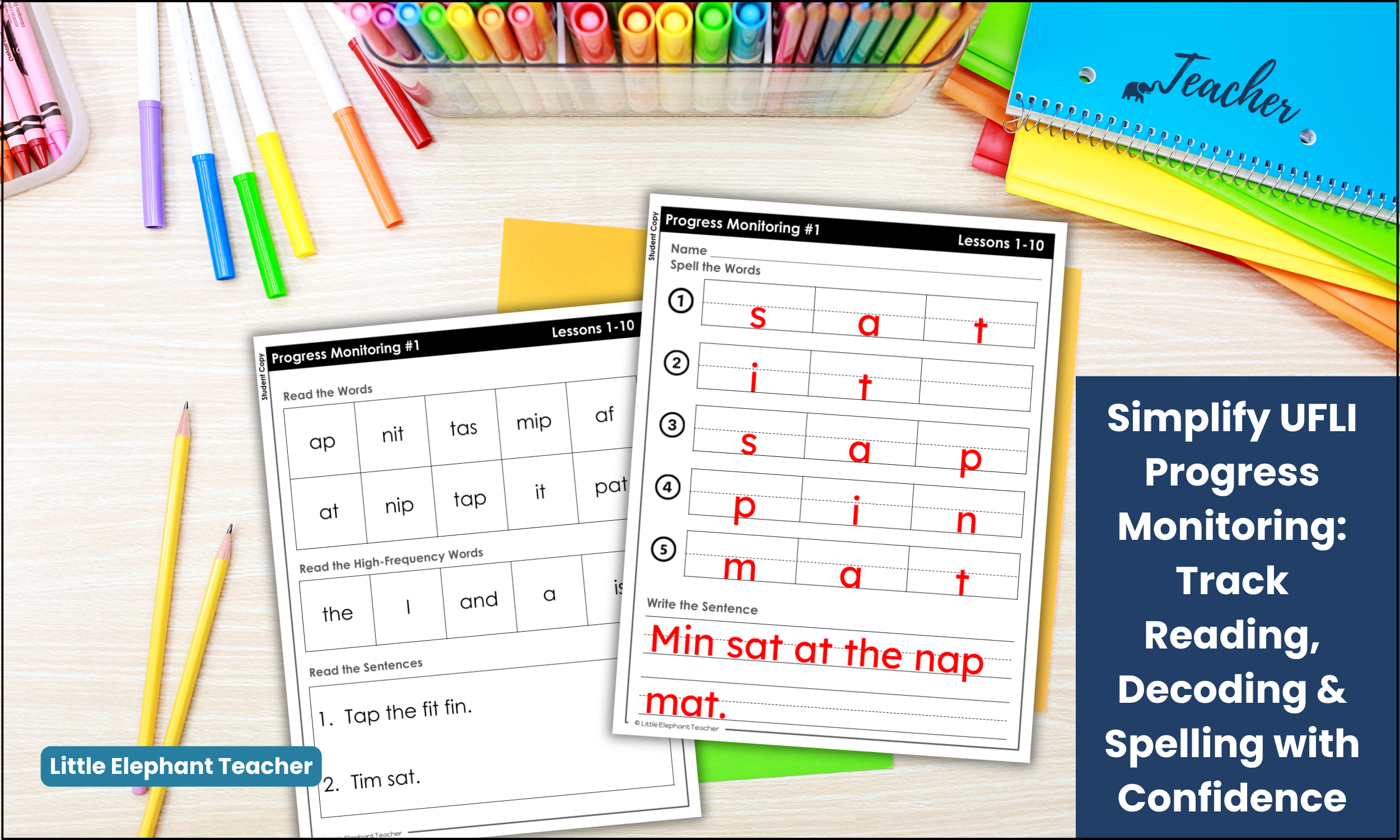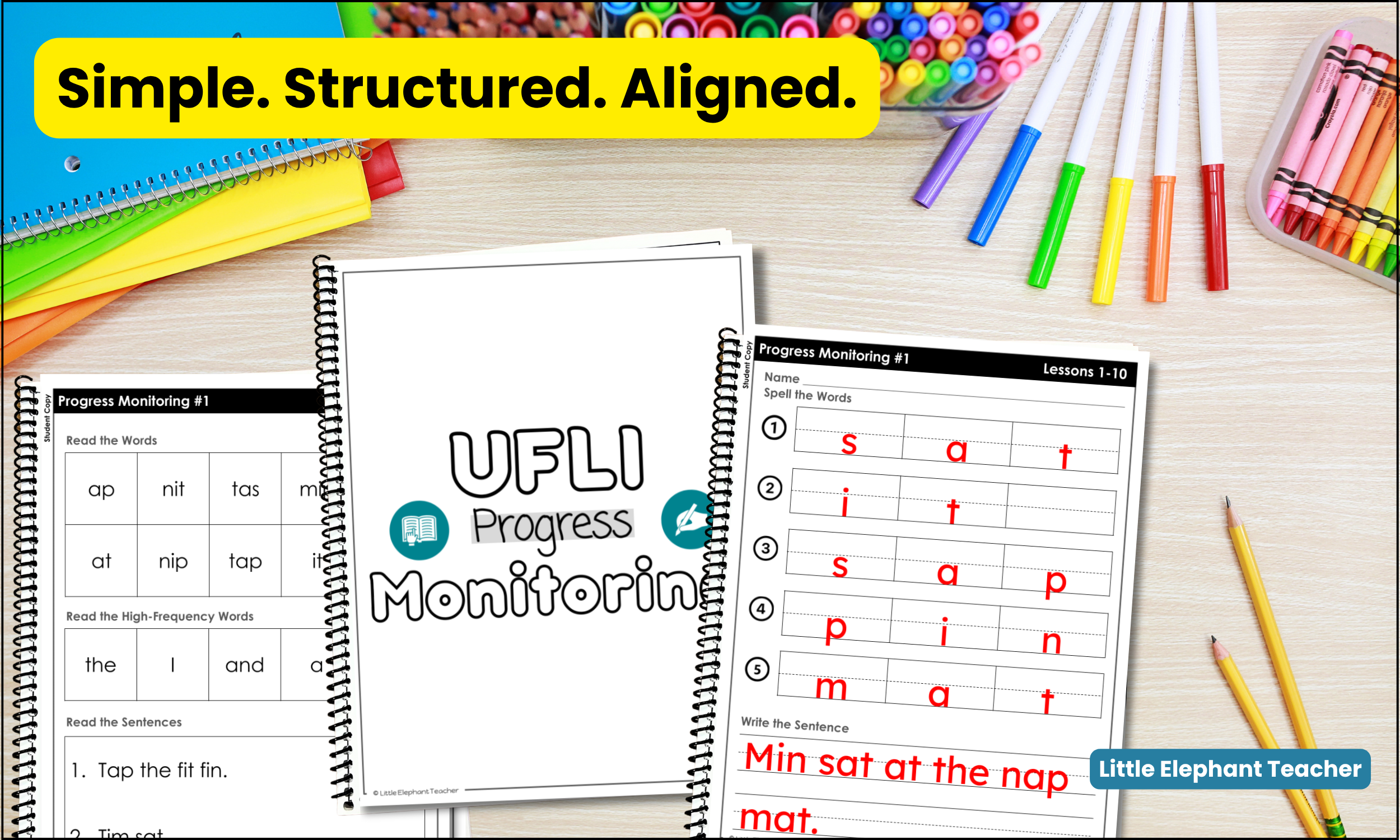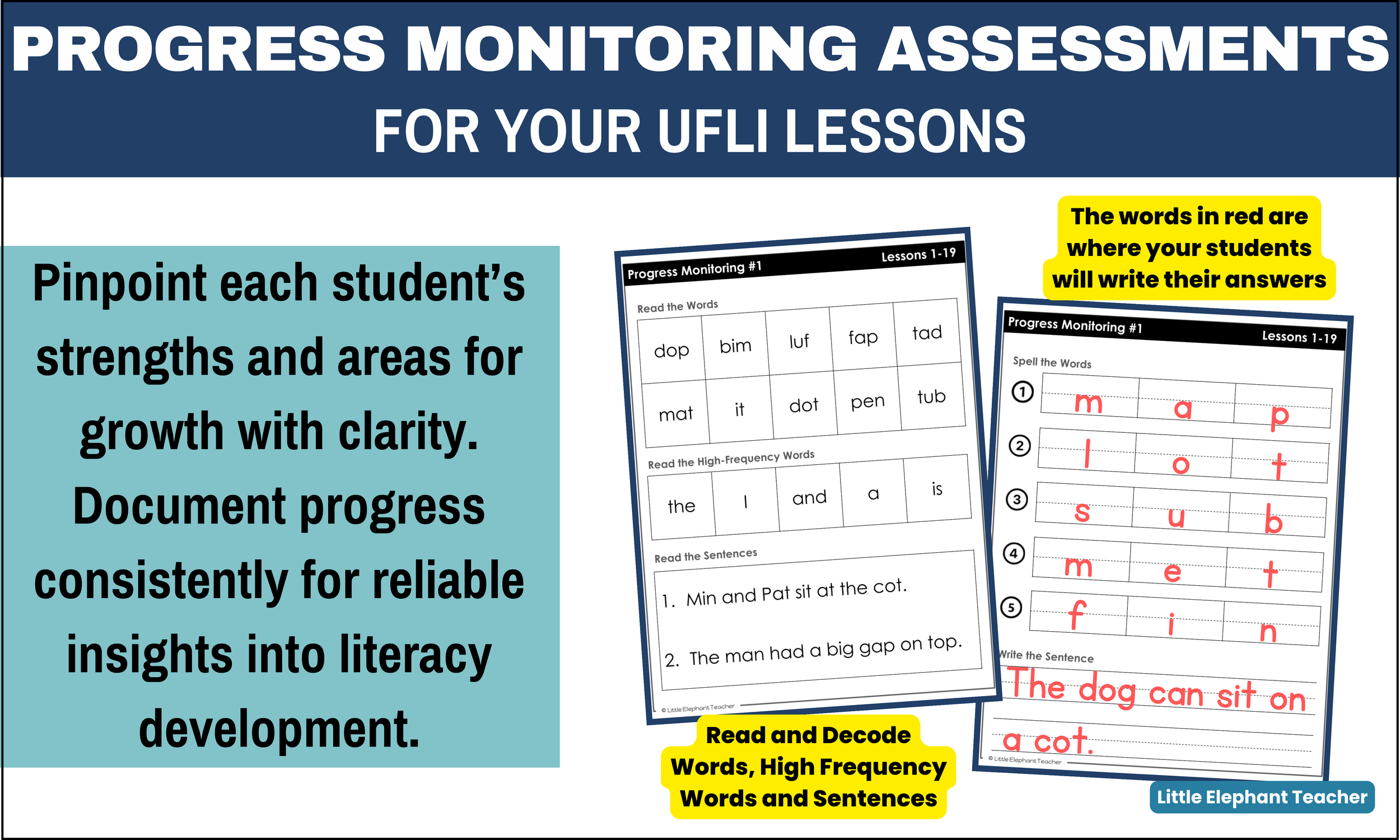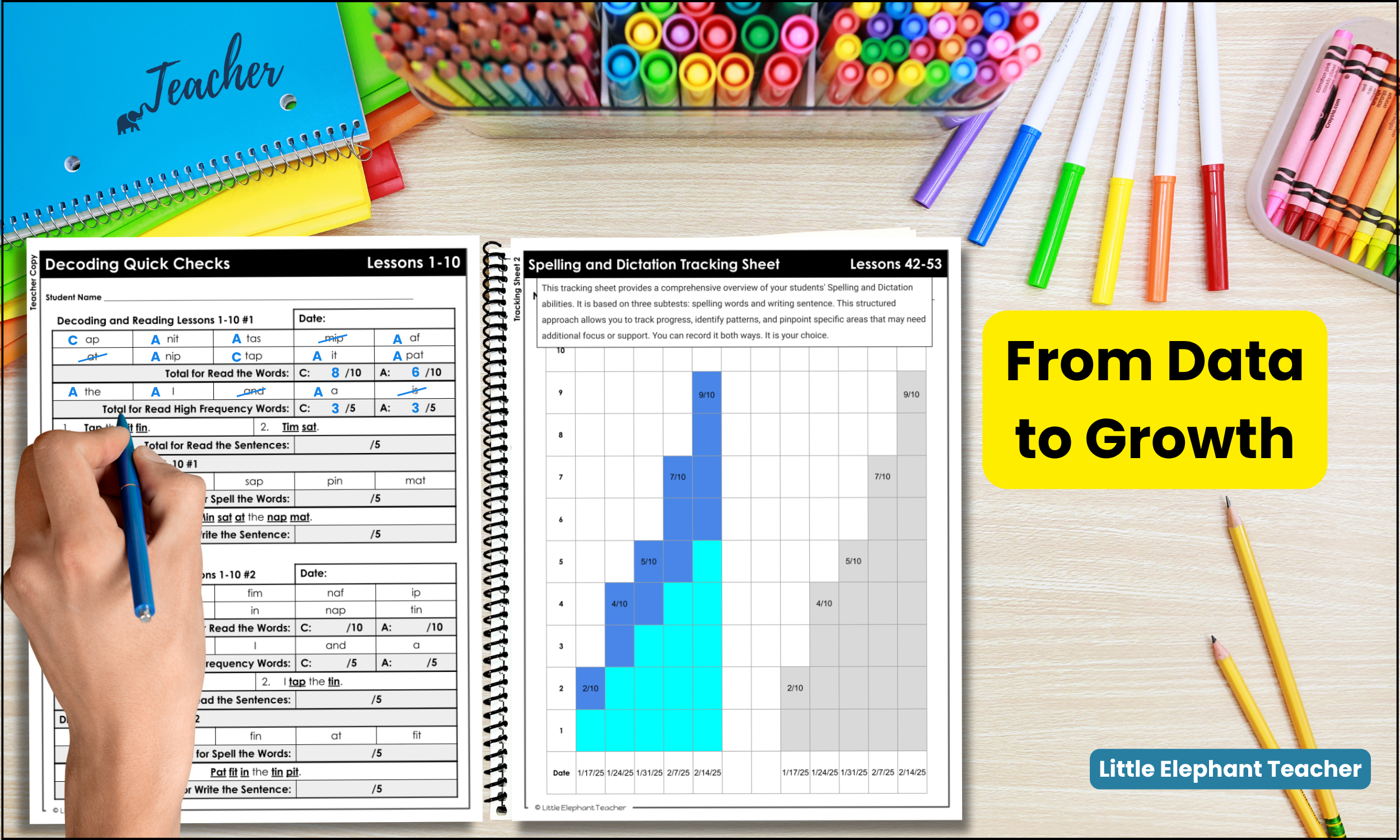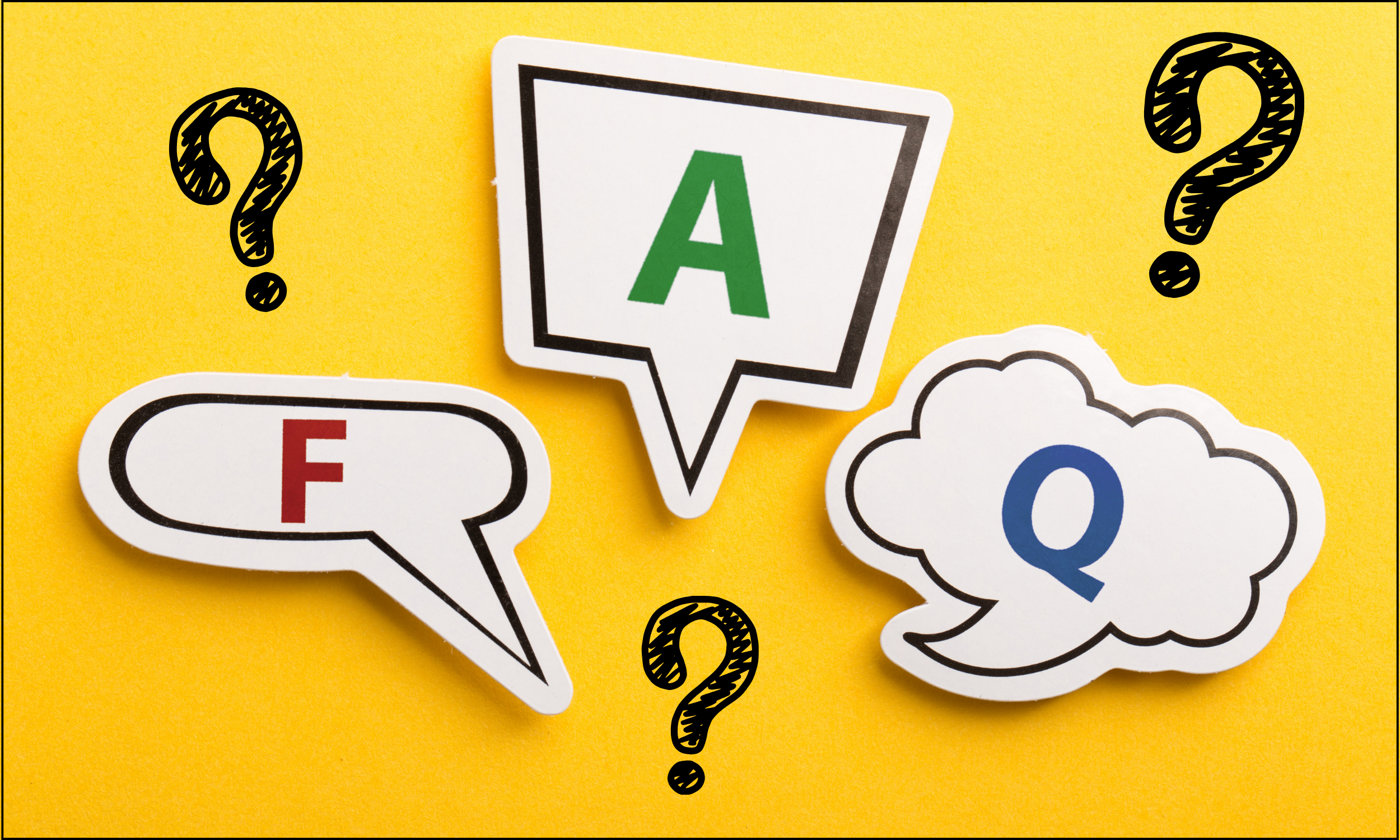UFLI Aligned Assessments: Simplify Progress Monitoring for Reading, Decoding & Spelling
If You’ve Ever Felt Overwhelmed by UFLI Progress Monitoring… You’re Not Alone
You love UFLI!
Your students are finally connecting sounds to letters, decoding with confidence, and spelling words they never thought they could.
But somewhere between Lesson 42 and Lesson 83, your binder starts to overflow.
Sticky notes. Clipboards. Random word lists.
You’re doing your best to track progress in reading, decoding, and spelling — but the data never quite adds up.
That’s exactly why I created the UFLI Aligned Progress Monitoring Assessments — to take the guesswork out of tracking literacy growth and give you a clear, teacher-friendly system that aligns perfectly with UFLI Lessons 1–128.
The Real Struggle: Tracking UFLI Progress Without Losing Your Mind
Progress monitoring matters. It’s how we measure growth, document IEP goals, and make data-driven decisions for small groups.
But let’s be honest — it can easily become overwhelming.
Teachers tell me their biggest challenges are:
“When do I assess?”
“How do I make sure it matches the UFLI lesson I’m teaching?”
“How can I track decoding and spelling without doubling my workload?”
Without a system that matches the UFLI Foundations scope and sequence, you end up piecing together your own assessments.
The result? Inconsistent data and too many papers.
That’s where this resource changes everything.
The Solution: UFLI Aligned Progress Monitoring Assessments (Lessons 1–128)
Designed by a teacher who uses UFLI daily, these UFLI-aligned reading, decoding, and spelling assessments are your go-to progress-monitoring toolkit.
What’s Inside
🧾 85 assessments covering all UFLI Lessons 1–128
✏️ Student pages + teacher scoring sheets
📊 Built-in graphs for tracking automaticity and growth
🔡 Reading & Decoding Section: 5 nonsense words, 5 real words, 5 high-frequency words, and controlled sentences
📝 Spelling & Dictation Page: teacher word list and sentences printed directly on the back
Each set aligns with specific UFLI lesson groups (digraphs, vowel teams, r-controlled vowels, etc.) and can be used during the unit to monitor progress or after to check mastery.
Why Teachers Love These UFLI Aligned Assessments
“So helpful for IEP data!” — Kristina K.
“Love how it aligns perfectly with UFLI. Great for student check-ins.” — Avery C.
“I use these every week to track decoding and spelling. Easy, organized, and accurate!” — Jennifer C.
What Makes Them Stand Out
✅ Perfect UFLI Alignment – Each page matches your current phonics focus.
✅ Comprehensive Coverage – Reading, decoding, and spelling in one tool.
✅ Teacher-Friendly Design – Print-and-go format with built-in scoring directions.
✅ Actionable Data – Simple codes + graphing sheets make student growth visible.
✅ Proven Effectiveness – Classroom-tested by real UFLI teachers.
My Friday Routine: Progress Monitoring Made Simple
I use these UFLI Aligned Progress Monitoring Assessments every Friday in small groups.
It’s my favorite part of the week — quick, calm, and consistent.
Step-by-Step
Print & Prep – Choose the lesson range you’re teaching (e.g., Lessons 42–53).
Assess Reading & Decoding – Students read the word list and sentences aloud; mark A/C, C, or I.
Assess Spelling – Dictate the words and sentences; mark correct (C) or incorrect (I).
Graph & Reflect – Students color their graphs to visualize progress and celebrate growth.
💡Teacher Tip: Consistency Beats Complexity
Even if you don’t use this exact resource, building a 10-minute weekly routine will transform how you see student growth.
With these UFLI Aligned Assessments, that structure is already built in — no formatting, no guesswork, just reliable, actionable data.
Turning Data into Action
After each assessment, I look for trends:
Which phonics skills are solid and automatic?
Where are students decoding slowly or inconsistently?
Are there spelling patterns that need more practice?
When 80% or more of a group reads or spells automatically, we move on.
If not, I reteach using targeted decoding and word-mapping.
This data-driven rhythm helps every student grow at their pace — with confidence and clarity.
For more ideas on supporting daily instruction, read How to Use UFLI Student Response Sheets for Daily Practice.
What Other Teachers Are Saying
⭐️⭐️⭐️⭐️⭐️
“This UFLI-aligned phonics resource is amazing! It fits perfectly with the lessons, is easy to use, and gives my students the practice they need to grow in confidence and skills.” — Jill S., 2nd Grade
⭐️⭐️⭐️⭐️⭐️
“These sheets are exactly what I needed for Tier 3 and IEP goal tracking. They follow the UFLI lessons perfectly. Worth every penny!” — Mara F., 6th Grade Interventionist
Ready to Simplify Your UFLI Progress Monitoring?
When you have the right tools, your data tells a story — not paperwork.
✨ Download the UFLI Aligned Progress Monitoring Assessments (Lessons 1–128) and start tracking reading, decoding, and spelling growth with confidence and clarity.
Your progress monitoring can finally feel purposeful — not overwhelming.
👉Get the UFLI Aligned Assessments on TPT
Bundle and Save
These assessments pair perfectly with the UFLI Aligned Student Response Workbook and Comprehensive UFLI Bundle — giving you everything you need for Lessons 1–128:
daily phonics practice → weekly progress monitoring → long-term data tracking → student mastery
In a Nutshell
Your time is precious — and so is your data.
These UFLI Aligned Assessments take the stress out of progress monitoring so you can focus on what really matters: teaching.
Pair them with the UFLI Student Response Workbook or the Comprehensive UFLI Bundle to build a complete, consistent system for reading, decoding, and spelling success from Lessons 1–128.
💡Ready to make progress monitoring easier and more meaningful?
Start today — your students (and your future self) will thank you!
Frequently Asked Questions: UFLI Aligned Progress Monitoring
1. How often should I give the UFLI Progress Monitoring Assessments?
Most teachers use one assessment each week or every other week. Each UFLI unit includes five assessments per lesson range, so you can rotate through them and repeat as needed. Consistent weekly check-ins provide the clearest picture of decoding and spelling growth.
2. Do these UFLI Aligned Assessments cover both decoding and spelling?
Yes! Each set includes both decoding (reading) and encoding (spelling) sections. Students read real and nonsense words, then complete a spelling dictation. This ensures you’re assessing phonics knowledge from both directions — reading and writing.
3. Can I use these assessments for IEP goals or RTI documentation?
Absolutely. Many teachers use the built-in graphs and teacher scoring sheets to track progress for IEP, RTI, and small-group intervention data. The structure aligns perfectly with data collection requirements while saving valuable prep time.
4. Do I have to finish an entire UFLI unit before assessing?
No — these assessments are flexible! You can give them weekly, mid-unit to check progress or after a lesson range to confirm mastery. For example, if you’re teaching Lessons 42–53 on digraphs, you can assess at Lesson 48 or wait until Lesson 53 for a full check-in.
5. What do the letters A, C, and I mean on the decoding sheet?
They’re simple scoring codes to make data fast and clear:
A (Automatic): Read correctly within about 2 seconds.
C (Correct): Read correctly but slowly or with self-correction.
I (Incorrect): Read incorrectly or skipped.
Tracking Automatic (A) responses shows which skills have become fluent — a key goal of phonics instruction.
6. Do the UFLI Assessments include teacher dictation lists?
Yes. Every spelling page includes a teacher copy with pre-written dictation words and sentences that match the unit’s phonics pattern. No extra prep or guesswork required.
7. Can I use these assessments if my school uses a different phonics program?
Yes! While these assessments are perfectly aligned to UFLI Foundations Lessons 1–128, the structure (real/nonsense words + encoding) works well with any Science of Reading–based phonics sequence.
8. How can I help students understand their own progress?
After each assessment, have students color their progress graphs to visualize growth. It builds motivation and ownership — and makes data meetings more meaningful for everyone.
9. Where can I find more UFLI-aligned resources to use with these assessments?
You can explore my full Comprehensive UFLI Aligned Bundle on TPT, which includes:
Progress Monitoring Assessments
Everything you need for UFLI Lessons 1–128 — all in one consistent, teacher-friendly system.
10. What’s the best way to organize all the UFLI progress monitoring data?
I recommend keeping a simple binder or digital folder with tabs for each lesson range. Store student sheets, teacher graphs, and checklists together — it makes IEP meetings, parent conferences, and intervention planning so much easier.
About the Author
Andrea Russman | Little Elephant Teacher
Andrea is a classroom teacher and curriculum designer who specializes in UFLI-aligned phonics and math intervention resources. Her classroom-tested materials help teachers across the country simplify instruction, track data with confidence, and build strong, joyful readers.
